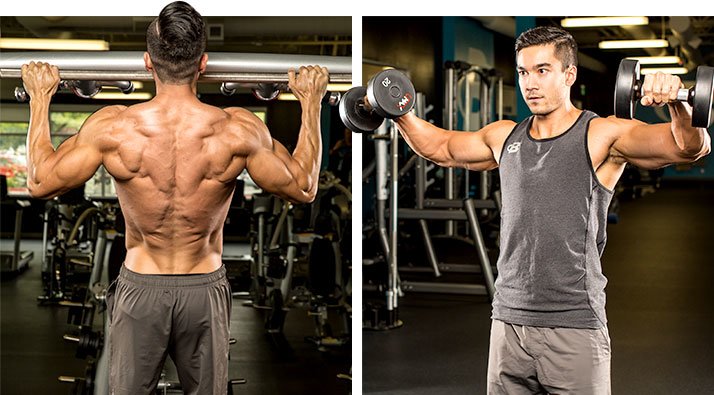
Combine These Exercises For Insane Gains
Say goodbye to playing it safe in the gym; sticking to what you know you're good at is a recipe for stalled progress. Try these innovative exercise pairings to patch up the chinks in your armor!
Paired sets—like supersets, but without the "no rest between" stipulation—allow you to make your workout denser and do more total work. Of course, that's not very helpful unless you pair the right exercises together. After all, the point of working out isn't simply to do as much as possible in the gym; you're trying to get stronger, right?
That's where "Grit sets," which pair the movements you're strong at with others that address your glaring weaknesses, come in. I can pretty much guarantee you've got one—or probably most—of the weaknesses listed here. In some cases, Grit sets may actually make your strong lift stronger!
Rest briefly between exercises, but no more than necessary. And don't worry: None of the pairings will require you to hog equipment or be that jerk with multiple weights piled up around him!
Grit Set 1: Bench press / glute work
Strength: Chest
Weakness: Glutes or hamstrings
Glutes are the new biceps; everyone wants to work them! I'm not just talking about bodybuilders and bikini competitors looking to bring a better package to the stage, either. Fitness enthusiasts from all walks of life want to look better in their jeans, but they also recognize how crucial glute strength is to their overall health and athleticism.
One Leg Hip Lift Exercise Tutorial
Watch the video - 1:45
To perform this Grit set, start by hammering the glutes on lower-body training days, mixing compound lifts like deep squats and deadlift variations with isolation work like 45-degree hip extensions, barbell hip thrusts, and the donkey-kick machine. I also like to add in some additional glute work on chest day. Doing it is as easy as rolling over.
After you've finished your set of benching, simply shift over to the side of the bench and perform single-leg hip thrusts. I prefer single-leg hip thrusts instead of barbell hip thrusts here for a few reasons:
- They can be done effectively with body weight or by simply holding a single dumbbell on the side you're pushing from.
- Nearly everybody has one glute that's stronger than the other.
- You won't be that guy in the gym hogging two barbells at the same time.
Alternately, you can focus your weakness work here on your hamstrings by performing single-leg hip lifts, where your foot is up on the bench and your shoulders are on the floor. Like hip thrusts, these don't require any special setup and can be progressed simply by adding a small weight to the loaded leg.
Grit Set 2: Vertical pull / shoulder raise
Strength: Lats
Weakness: Shoulders
It can be hard to cram in enough shoulder work into one workout, especially if that workout also includes chest and triceps. In this case, I recommend adding in some extra shoulder work on a back-focused day. My favorite way to do this is by pairing vertical pulls like lat pull-downs or pull-up variations with dumbbell shoulder raises.
45-Degree Shoulder Raise Exercise
Watch the video - 00:41
I like pairing these together for a couple of reasons. First, they're opposing actions at the shoulder joint, which allows them to be done back to back without interfering with the performance.

Bring the dumbbells over to the chin-up bar or lat pull-down machine so you don't have to walk around the gym and potentially lose your spot. This is especially important when you're training in a big-box gym at prime time, which is also why all of the sets provided in this article share this same quality.
Since it's a back-focused training day, the shoulder raises will be done second in the set, after completing the pulls. You can use pretty much any variation of dumbbell shoulder raises: front, side, or 45-degree raises halfway between.
Grit Set 3: Bench press / rotator cuff work
Strength: Horizontal pressing
Weakness: Shoulder external rotation
A lot of what you do in the gym involves shoulder internal rotation. Nearly all pushing exercises, as well as a surprising number of pulls, put you in an internally rotated position. However, most people's programs lack targeted shoulder external rotationn work to balance it out.
Additionally, the movements that do manage to make it into programs—cable external rotations, band external rotations, and those little plate-wavey things—all kind of suck, to be frank. For example, when performing the traditional standing external rotation with band, it's easy to inadvertently substitute lumbar-spine extension—bending backward—for external shoulder rotation. It'd be hard to tell the difference.
You might think you're doing the exercise correctly, when in reality you're cheating the external rotators by not working them through their fullest available ROM. You're also teaching your body to use a dysfunctional movement pattern.
A few years ago, I figured out that the easiest way to fix this problem is to simply get on the floor and perform a supine band shoulder external rotation. It's a mouthful, but man is it effective!
New Shoulder External Rotation / Rotator Cuff Exercise
Watch the video - 3:23
Over the years I've had many clients and athletes tell me they feel that performing some light sets of the band shoulder external rotations in between their sets of heavy barbell or dumbbell bench presses helps their shoulder feel less tight and more ready to do the next set of presses. I don't know of any studies to back this up, but it's been my experience as well. So take that for what it's worth!
Grit Set 4: Abs / Posterior chain work
Strength: Posterior chain
Weakness: Anterior core
The glutes, hamstrings, and lower back aren't weaknesses for everyone. Plenty of people have seen the writing on the wall and gotten their backsides strong by using a combination of classic multijoint strength moves and targeted accessory work like barbell Romanian deadlifts (RDLs), single-leg dumbbell RDLs, 45-degree hip extensions, reverse hip extensions, and stability-ball leg curls.
Since all of those exercises essentially focus on the posterior core musculature (i.e., glutes and lower back), I like to pair these moves with anterior-core-focused (i.e., abdominal) exercises.
Killer Abs Exercise Pike Roll Out on Fitness Ball
Watch the video - 1:55
Before you go start blindly repeating the old "heavy squats and deadlifts are all I need to strengthen my abs and obliques" mantra, let me save you the typing time. No, they're not enough, particularly when it comes to the anterior core. Likewise, I'm not in the "no spinal flexion allowed" camp, due to a lack of convincing evidence that I should be. That said, I pair both flexion and anti-extension abdominal-focused exercises with posterior-chain exercises.
Two of my favorite abdominal exercises to do following a set of posterior-chain work are stability-ball plate crunches and the stability-ball pike roll-back. I've found these two abdominal exercises make a nice compliment to the posterior-chain exercises, particularly because many athletes over the years have said that these moves help offset some of the lower-back muscle tightness—I said tightness, not pain—that results from using the back extensors during posterior-chain exercises.
If you want something without spinal flexion, you've got options, too. Stability-ball stir-the-pots and single-arm planks are great anti-extension exercises to pair with posterior-chain work.
Grit Set 5: Straight-arm pull-down / face pull
Strength: Triceps and lats
Weakness: Upper/mid back and rear delts
One of my go-to pairs on back-training days consists of performing a set of face pulls, then using the same rope to perform a set of straight-arm pull-downs.
This pair works well, not only because it allows you to hit two different areas of the back musculature, but also because both exercises can be performed back to back, in the same place, with the rope attached high on the cable column.
Straight Arm Cable Pull Downs 3 Variations - Lats Exercise
Watch the video - 00:29
I also perform a triset of triceps extensions, face pulls and straight-arm pull-downs on occasion, as all three of these exercises can be performed in the same place with the same rope handles at the same high attachment point on the cable column. On a chest, shoulders, and triceps day, you can also just do some face pulls between sets of triceps extensions.
No matter where you do them, face pulls allow you to get in some extra volume for the rear delt and middle-back muscles, two areas of weakness and underdevelopment for physique-sport competitors, athletes and exercise enthusiasts—in other words, pretty much everybody in the gym.
Grit Set 6: Biceps curl / dumbbell A
Strength: Biceps
Weakness: Upper/mid back and rear delts
Because the upper back and rear delts are such a common weak spot, you may benefit from an additional Grit set to target them. One of my most-used paired sets combines dumbbell biceps curls with dumbbell shoulder A's, which are a variation of rear-delt flyes that also target the posterior shoulders and middle-back musculature.
Here's how to perform shoulder A's:
Shoulder A's
Watch the video - 1:12
I like this paired set for three reasons:
- Like the other paired sets above, both exercises use dumbbells, so they can both be performed in the same spot.
- The shoulder A's also require an isometric contraction of the triceps, which helps to serve as a "diverting exercise" to the biceps curls that preceded them. Your biceps will be forced to relax and recover, making these moves an ideal match.
- Back and biceps often go together in a program, and this paired set covers both areas. That said, this paired set can also be done if you're doing an arm-focused day in order to get some extra middle-back work in, which, as I already said, you probably should be.
Pair Up and Grit It Out
Using paired sets when doing total-body workouts for the purposes of maximizing strength is nothing new—it's just something that's widely misused. So if you're doing full-body routines, feel free to blend any of these into the mix and see if they're more effective at helping you maintain strength throughout your session.
However, these pairings are especially effective for body-part-split training programs. I use them regularly with clients and athletes who are interested in maximizing muscle development in their weaker areas. If you're not interested in that, just keep doing what you're doing. It'll catch up with you eventually!

